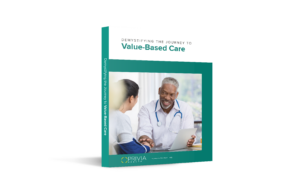A recent landmark report from Health Affairs concluded that value-based care is “perhaps the only systemic intervention available that can simultaneously address” four key levers needed to curb healthcare’s increasing, unsustainable spending trajectory:
- Price: Paying the most efficient price for care.
- Volume: Ensuring the appropriate quantity of care.
- Mix: Ensuring the appropriate types of services for given patients and populations.
- Growth: Growing the price and volume sustainability and maintaining an appropriate mix over time.
However, many physicians note that insufficient or unusable data stymies the volume-to-value transition. Research indicates that 46 percent of physicians agree that a “lack of data … makes it difficult to support value-based care.”
To simplify value-based care’s data needs, we created Demystifying the Journey to Value-Based Care. This free, comprehensive guide contains research-backed insights from a diverse group of thought leaders.
Here’s a preview of the actionable information contained in the guide.
 Fred Taweel, MD (Chief Medical Officer, Privia Medical Group — Mid-Atlantic): “To advance value-based care, it’s essential that you establish a culture of transparency and accountability through data sharing.”
Fred Taweel, MD (Chief Medical Officer, Privia Medical Group — Mid-Atlantic): “To advance value-based care, it’s essential that you establish a culture of transparency and accountability through data sharing.”
To excel in value-based care, physicians must view patient care through a data-driven lens. Seeking, analyzing, and incorporating data into workflows is essential and takes many forms. For instance, clinical teams can compile data for the purposes of risk stratification. This approach can inform care management, improve outcomes, and lower costs, which in turn can increase reimbursements.
However, comprehensively gathering data is a common challenge, and research shows that more than 80 percent of physicians have “added data analytics and reporting tools to accommodate the shift to value-based care.”
But aggregating data is only half the battle. The next challenge is accurately interpreting data, extracting insights, and adjusting behaviors. While technology is key, there’s another powerful tool: peer-to-peer data sharing.
When done right, physician-led governance:
- Unites providers around shared goals and incentives
- Amasses data around quality, cost, outcomes, and utilization
- Creates a forum to seek help from experienced peers
- Facilitates collaborative conversations around the methods and strategies that fuel results
To promote this constructive environment, governance organizations should adhere to three tenets, which are explored in greater depth in our free guide:
- Physician-led
- Transparent
- Purpose-built
 Chris Voigt (Executive Vice President & Chief Technology Officer, Privia Health): “Integrate data-driven actions at the point of care.”
Chris Voigt (Executive Vice President & Chief Technology Officer, Privia Health): “Integrate data-driven actions at the point of care.”
While physician-led governance creates a space to collectively review data and brainstorm improvements, these discussions are retroactive. It’s also helpful to step back and consider what the data represents: a summary of numerous decisions made at the point of care. Therefore, it’s essential to highlight ways to incorporate data during visits.
The most powerful tool for accessing data at the point of care is your electronic health record (EHR). As detailed in the guide, key real-time data worth exploring include:
- Intelligent Aggregation: EHRs can compile and organize data from external sources, such as hospital discharge summaries and health information exchanges.
- Built-In Referral Networks: The American Medical Association points out how EHRs can tier specialists and facilities based on quality, in-network status, patient cost-share, and payer-quality ranking.
- Data Mining and Sharing: The vast array of data can help identify at-risk patients who may benefit from chronic care management or other programs.
- Helpful Reminders: EHRs can identify open care gaps during visits, prompting physicians to close them. It also can send messages via the patient portal and use patient-reported data to close gaps.











Related Articles
How to Keep Your Patients From Skipping Mammograms
Kristin Schraa, MD, with Virginia Women’s Center shares how women’s health providers can encourage patients ...
3 Ways Healthcare Can Integrate Behavioral Health and Primary Care
Integrating behavioral health with primary care can lead to better patient outcomes — but how ...
How Can Physicians Support Postpartum Mental Health?
On average, 13 percent of mothers in the United States will develop symptoms of postpartum ...
Engaging Patients in Annual Mammograms
Studies show that a little over 66 percent of women aged 40 and older get ...
What Do Medicare-Aged Patients Want in Their Healthcare?
Within the next 20 years, 20 percent of Americans will be 65 or older. It ...
How Health Systems Grow Stronger With Privia Health
Discover how we helped Health First upgrade technology, align physicians, and accelerate toward value-based care. ...